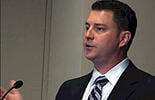by Ryan H. Flax, Esq.
(Former) Managing Director, Litigation Consulting
A2L Consulting
In our two previous posts, we discussed two important roles that an opening statement can play: making you and your client appealing to the jurors, and telling a convincing story. Here are two other key functions for an opening statement.
Showing How the Facts Fit the Law
You cannot argue in an opening statement. That is objectionable. But you can accurately tell jurors what you need and intend to prove to win, thus giving the jurors in effect a list that they can check off during the trial. Don’t tell the jury what the law is; that’s for the judge to do. Instead, tell them what you’re going to prove and why it’s important. You’ll want to combine this with your storytelling. Most cases aren’t as complicated as lawyers think they are, and if jurors are to do their job, they simply can’t be too complicated. Boil down the things you need to prove into a simple list. Tell the jury that you’re going to show them all these things.
For example, in a basic breach of contract case the question is: Shouldn’t a deal be honored? To win the case, you need to first show that there was a valid contract, that it was reasonable, and that there was performance by your client.
Once you’ve established the framework of proof, give your jurors a taste of the evidence that will be presented at trial and explain that it’s enough to win without any more evidence (but of course there will be more). For example, there is already deposition testimony from the defendant that there was an agreement, a contract. The defendant has also already conceded in testimony that the amount in the contract was reasonable. Finally, there can be no doubt that our client performed under the contract. Now, if we can just get a stipulation from the defendant that he hasn’t paid our client, we’re there.
Now that the jury knows what to expect at trial, they’re primed and they have a working outline for the trial.
Deflating The Opponent’s Balloons
Every case has a weakness, even yours. How do you handle weaknesses in the opening statement? Beat your opponent to the punch — identify your opposition’s strongest points and explain why they don’t matter. Bringing out weak points in your case in as positive a way as possible takes the sting out of the issues, makes you appear honest, and lessens the negative impact of your opponent pointing them out.1
If you go first and identify for the jury what opposing counsel will say in their opening and discount it, you’re already winning. Lawyers who ignore their weaknesses lose credibility. Jurors will not believe a lawyer who is perceived to be hiding important facts.
The key to handling weaknesses is to make them part of the story and turn them around. Admit them as if they were “no big thing” or if they seem to be a big deal, explain why they’re not really that big. Reason and logic rule: You’ll need a reasonable and convincing but terse explanation for why your client waited three years to sue or why a couple of beers before heading home didn’t matter.
Deflating balloons doesn’t mean telling the jury about every single piece of conflicting evidence or argument the opposition may use. Deal with major problems that could really matter if left to your opponent to introduce.
Other A2L Consulting articles and resources for opening statements, trial presentation and litigation consulting support generally:
- Planning For Courtroom Persuasion? Use a Two-Track Trial Strategy
- 4 Tips for Stealing Thunder in the Courtroom
- Request a conflicts check to help A2L work on the "right" side of a case
- Claim a free subscription to this blog
- Why a litigator is your best litigation graphics consultant
- 6 Reasons The Opening Statement is The Most Important Part of a Case
- How to Structure Your Next Speech, Opening Statement or Presentation
- 5 Ways to Maximize Persuasion During Opening Statements - Part 1
- 5 Ways to Maximize Persuasion During Opening Statements - Part 2
- Don't Be Just Another Timeline Trial Lawyer
- Free Webinar: Opening Statements Webinar and Persuasion
[1] J. Alexander Tanford, The Trial Process: Law, Tactics and Ethics 3d, at 169 (2002).






Leave a Comment